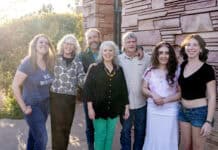After passing financing for the Uptown parking garage during the June 11 meeting, the Sedona City Council expressed unanimous support for Yavapai County constructing multiple crossings of Oak Creek to reopen alternative routes and relieve traffic congestion.
During his presentation to council on possible future transport collaborationss with the Northern Arizona Council of Governments, Deputy City Manager Andy Dickey proposed that the city begin “renewing a discussion on a need for a regional connection.”
“In 2018, we completed the transportation master plan, and one of the strategies within that master plan was SIM-13,” Dickey elaborated. “That particular strategy did identify a specific connection specifically at the Red Rock Crossing, the idea being that there is a need to connect from the south of the city to the west. This would be a connection that allows for bypassing congestion. At the time we did through our analysis determine that this would not necessarily be a congestion relief due to the anticipated amount of traffic that would bypass the congested area.”
“While that particular strategy did identify a specific connection, this renewed discussion is really centered on looking at the idea of multiple possible connections and whether or not the city wants to advocate to Yavapai County the possibility of analyzing those alternative connections,” Dickey continued. “Both NACOG and Verde Valley TPO are pursuing a transportation master plan update right now and so the city would notify them about the city’s desire to pursue this.”
Mayor Scott Jablow asked how the city would have standing with the county to pursue reopening of Red Rock Crossing, which is outside the city limits.
“I think we would go to the county and let them know they have the city’s support,” Dickey said. “Maybe advocating for certain funding opportunities that might be utilized with this sort of effort … just making it clearer to the county that the city is at the table and willing to help.”
“That might be the intent of the alternative analysis, to look at what options might be out there,” Dickey added. “Maybe that’s part of the partnering we do with the county is looking at alternatives.”
City Attorney Kurt Christianson reminded the council that in addition to entering into intergovernmental agreements to pursue such a project, “the city can also annex roadways outside of city limits and just annex the roadways.”
All seven council members said they were in favor of such a proposal.
“I’m supportive of the SIM-13 notion of trying to move that forward,” Councilman Brian Fultz said. “I think we do owe it to look at that periodically.”
“Any time we can make diversionary tactics for moving traffic and people around the city, it’s a good thing,” Councilwoman Melissa Dunn said. “I think it’s certainly worth investigation. We hear about it all the time.”
“For many years it’s almost been a sacred cow to not do a bypass,” Vice Mayor Holli Ploog said. “This is going to be a long process. It’s time to get started. I will give the [Sedona] Red Rock News credit for pounding us on this … We’re going to have to just bite the bullet, I think, and get started, because it’s probably a five-to-10-year process.”
“There need to be four, six, whatever locations looked at all at one to see what is feasible and what would it take at each,” Councilwoman Kathy Kinsella said. “This is a personal priority now for me I’ve established for myself this year … there needs to be an alternate way to get around Sedona … We just can’t put our heads in the sand anymore.”
“Ditto,” Councilman Pete Furman said.
“I like the idea of not just one but three or four different ways,” Councilwoman Jessica Williamson said. “Then it’s not just a question of one person’s neighborhood, it’s a question of four peoples’ neighborhoods, and I always loved spreading it around.”
“We need to do something. There’s not question in my mind now is the time,” Jablow said. “I’m just worried about the pushback we’re going to get.”
The single public comment was made by Lars Romig, who supported the idea of regional connections, proposed the council look at reopening Chavez Crossing and asked the council to make sure that the area “was site-hardened really well” to prevent roadside parking along those roads.
Possible Routes
Council discussion mentioned two specific crossing locations:
- Improving and utilizing the existing lowwater crossing at Oak Creek Cliffs Drive, the historic Chavez Crossing, behind Poco Diablo Resort, as a connector route by extending Oak Creek Cliffs Drive along the north bank of the creek to join up with Chavez Ranch Road, thereby creating a link to Red Rock Loop Road and West Sedona.
- Reconstructing the historic Red Rock Crossing to reconnect Verde Valley School Road with Red Rock Crossing Road at the Crescent Moon Picnic Site as an alternate route to West Sedona. This lowwater crossing existed for decades before floods washed it in out in 1978, 1983 and 1993. The U.S. Forest Service granted an easement in 1986. In 1996, the Yavapai County Board of Supervisors announced its intention to build a 2,000-foot-long, 47-foot-wide bridge 27 feet above the creek near the site, but it was never built.
